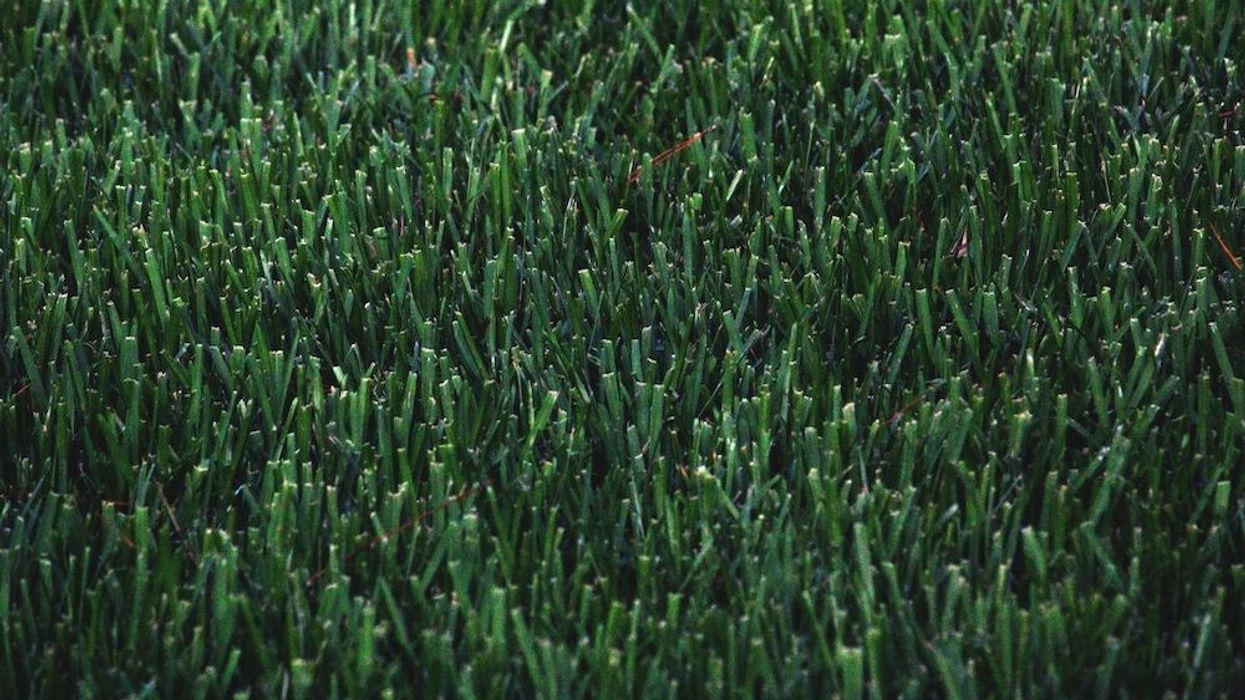Lush, green grass is something to be admired. After all, keeping a lawn looking pristine is no easy task, especially when there’s unpredictable weather and plenty of neighbourhood dogs creating patches in the greenery.
That’s why some residents choose to install artificial turf instead. “We had a lot of trouble keeping our lawn green and weed free,” Scarborough homeowner Sangeeta Gounder told CTV News. “It was just a lot of work to keep it up to the standard we wanted it.”
READ: 5 Beautiful Backyard Landscaping And Patio Ideas To Live Your Best Summer At Home
Unfortunately, three years after investing in her synthetic lawn, Gounder received a notice that her fake grass violated a Toronto bylaw.
A “minimum of 75 per cent of the front yard must be soft landscaping,” according to the bylaw. The City of Toronto defines soft landscaping as an area that “supports the growth of vegetation and permits infiltration into the ground.” Artificial greenery does not meet this requirement, thus is considered a hard surface, CBC reports.
READ: The Best Neighbourhoods To Live In Within And Around The GTA
Gounder is now required to remove her artificial lawn, or face a fine of $1,400. However, fighting the bylaw could cost even more, which is why she’s decided to replace her lawn with real grass later this summer.
Artificial turf certainly sounds like a dream, which explains why it’s been gaining popularity in recent years, despite the fact that it is prohibited in many cities. But is it really all it’s cracked up to be?
Here we weigh the pros and cons of having a synthetic lawn.
PROS
1. It’s less work to maintain.
Note that we did not say no work, just less work. Although fake grass eliminates the need for watering, mowing, fertilizing and removing weeds, it still needs to be raked occasionally, as fallen leaves and other debris could make it appear unkempt.
2. It stays green all-year-round.
No need to worry about sunspots or other discolouration. According to Heavenly Greens, an artificial grass company based in California, most artificial turf manufacturers offer a “no fade guarantee.”
This means shade and/or direct sunlight isn’t an issue. While the greenery may experience a slight one or two per cent colour change over the years, it will be minor.
3. It’s highly durable.
“Artificial turf can withstand constant sunlight, extreme heat and high levels of foot traffic for long periods of time and not degrade, breakdown or fade,” Heavenly Greens notes. That means your kids (and pets!) can play on the fake grass all they want without fear of destroying it. The fact that there’s no mud or dirt is also a bonus!
4. It can reduce allergies.
It’s not uncommon for people to be allergic to the pollen that comes from grass. That’s why replacing a live lawn with a fake one can help prevent allergies from being triggered.
This is one of the reasons Quebec City homeowner Martin Dignard installed artificial turf. “I had a lot of allergies when I cut the grass and so does my wife’s son,” he told Global News last year.
Unfortunately, Quebec has a similar bylaw to Toronto when it comes to fake grass, and Dignard was also ordered to remove his synthetic lawn.
CONS
1. It’s not as environmentally friendly as you think.
Although some artificial lawns are made of recyclable material, not all are. This has a big impact on the environment.
As Mathew Frith, London Wildlife Trust’s director of conservation, explained to The Guardian: “You are using fossil fuels to make it, so there is a carbon impact there, you have to remove a significant amount of soil to lay it so you are reducing the direct and indirect porosity of the soil, you are removing habitat which a wide range of species are dependent on and at the end of its life this is a non-biodegradable product which ultimately goes back into landfill.”
2. It can be pricey.
Artificial turf can cost anywhere between $8 and $12 per square foot to be installed, the Toronto Star reports. That means fake grass needed to cover a 500-square-foot yard could cost between $4,000 and $6,000. While an artificial lawn will save money on water bills, the upfront cost can be steep.
3. It can increase the risk of flooding.
Artificial turf “does not absorb water as fast as it would through natural ground cover,” according to the City of Toronto. That means there’s more risk of flooding after heavy rainfall or snow melts.
Additionally, water that sits under the artificial lawn could cause problems with the installation base, Portland landscaping company Ross NW Watergardens noted. This means drainage might also have to be installed as well, which would be an additional cost.
4. It can melt.
Artificial turf has a very high melting point of 93C or 200F. Although outside temperatures would never hit this extreme, that doesn’t mean there's zero chance of the turf melting. Energy-efficient windows that reflect light away from the home can magnify the sun’s rays and cause the turf to melt. Unfortunately, this circumstance is not always covered in a manufacturer's warranties.
The fact that the fake grass can heat up (unlike natural grass) is also a downside since this contributes to “urban heat buildup.” Trees and vegetation normally help monitor this.
5. It could affect your health.
Tire crumbs are used in artificial turf to mimic soil, but studies have found that these crumbs contain harmful chemicals.
“Exposures to chemicals present in crumb rubber at very high levels are known to cause birth defects, neurologic and developmental deficits, and some can even cause cancer,” Mt. Sinai Children’s Environmental Health Center previously wrote.





















